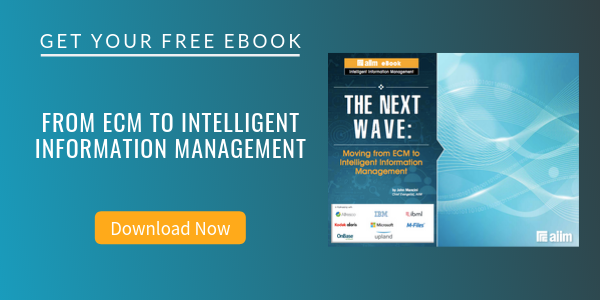
Rethinking the Intersection of People, Process, and Technology
Intelligent Information Management (IIM)
Organizations have long struggled with the magic “triad” of people, processes, and technology. This struggle has remained constant through multiple generations of technology – from paper to microfilm to imaging to document management to enterprise content management.
In order to understand what is coming next for content management, we need a clear understanding of where we’ve been.
|
Document Management & Workflow Circa 1995 |
Enterprise Content Management Circa 2005 |
Mobile and Cloud Content Management Circa 2015 |
|
|
People |
Solutions are difficult to use and require lots of training, but it does not matter because the people who use these systems are records and document specialists. |
Focus shifts from ECM “specialists” to knowledge workers, but usability still not a top priority. |
Usability becomes everything. Lines blur between home and the office. Even individual users can implement their own solutions. |
|
Processes |
Focus is on automating content-intensive, complicated, mission-critical processes; solutions confined to departments at large Fortune 500 organizations. |
ECM believes it’s an enterprise layer, but is often still driven by departments. Silos explode. ECM reaches into more organizations, but still basically a large organization game. |
Process owners can implement their own solutions. Business processes must be “appified.” “Good enough” content management solutions emerge for the SME market. |
|
Technology |
Complex, custom, and expensive implementations purchased by business buyers. No standard document body of knowledge exists. |
Rise – and then decline – of the “suites,” and focus shifts to the technology buyer. SharePoint disrupts the traditional ECM market. |
Configuration, connection, and mobile skills become key. Awareness grows that perimeter-based security no longer sufficient. File sync and share and cloud solutions disrupt the market and organizations struggle with the drag of legacy systems. |
As a result, most organizations at scale now have multiple generations of content technologies in place – and all of the multiple repositories that go along with this. Even if the term “ECM” ultimately moves to the background, the need for “ECM” capabilities is not going away -- organizations still have a need to automate core back-end, document-intensive processes, and many have yet to do so. In addition, organizations that have already implemented these solutions are not about to cavalierly rip them out. So the challenge for end-user organizations is to understand the new opportunities afforded by looking at content challenges through a new “lens” and build strategies that connect these opportunities to their existing core back-end ECM systems.
Organizations now face these core challenges at the intersection of people, processes, and technology:
- How do we adapt these systems to the coming wave of massive data?
- How do we understand and utilize what is in these systems to solve the next generation of problems?
- How do we strategically migrate from legacy content systems to more modern ones – and still keep the lights on?
- How do we give our employees and associates the tools – and information – they need to delight their customers?
Creating a strategy to federate access to content and information – a content abstraction tier if you will -- is central to this journey. Without it, organizations will continue to wander in the wilderness of multiple and inconsistent repositories, frustrated at their ability to optimize the vast quantities of the information under their control.
About John Mancini
John Mancini is the President of Content Results, LLC and the Past President of AIIM. He is a well-known author, speaker, and advisor on information management, digital transformation and intelligent automation. John is a frequent keynote speaker and author of more than 30 eBooks on a variety of topics. He can be found on Twitter, LinkedIn and Facebook as jmancini77. Recent keynote topics include: The Stairway to Digital Transformation Navigating Disruptive Waters — 4 Things You Need to Know to Build Your Digital Transformation Strategy Getting Ahead of the Digital Transformation Curve Viewing Information Management Through a New Lens Digital Disruption: 6 Strategies to Avoid Being “Blockbustered” Specialties: Keynote speaker and writer on AI, RPA, intelligent Information Management, Intelligent Automation and Digital Transformation. Consensus-building with Boards to create strategic focus, action, and accountability. Extensive public speaking and public relations work Conversant and experienced in major technology issues and trends. Expert on inbound and content marketing, particularly in an association environment and on the Hubspot platform. John is a Phi Beta Kappa graduate of the College of William and Mary, and holds an M.A. in Public Policy from the Woodrow Wilson School at Princeton University.


